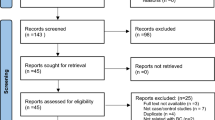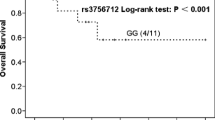Abstract
Bladder cancer is the fourth most common malignancy in men and the eighth most common in women in western countries. Single nucleotide polymorphisms (SNPs) in genes that regulate telomere maintenance, mitosis, inflammation, and apoptosis have not been assessed extensively for this disease. Using a population-based study with 832 bladder cancer cases and 1,191 controls, we assessed genetic variation in relation to cancer susceptibility or survival. Findings included an increased risk associated with variants in the methyl-metabolism gene, MTHFD2 (OR 1.7 95% CI 1.3–2.3), the telomerase TEP1 (OR 1.8 95% CI 1.2–2.6) and decreased risk associated with the inflammatory response gene variant IL8RB (OR 0.6 95% CI 0.5–0.9) compared to wild-type. Shorter survival was associated with apoptotic gene variants, including CASP9 (HR 1.8 95% CI 1.1–3.0). Variants in the detoxification gene EPHX1 experienced longer survival (HR 0.4 (95% CI 0.2–0.8). These genes can now be assessed in multiple study populations to identify and validate SNPs appropriate for clinical use.

Similar content being viewed by others
References
Ahsan H, Thomas DC (2004) Lung cancer etiology: independent and joint effects of genetics, tobacco, and arsenic. JAMA 292:3026–3029
Alvarez A, Lokeshwar VB (2007) Bladder cancer biomarkers: current developments and future implementation. Curr Opin Urol 17:341–346
Andrew AS, Nelson HH, Kelsey KT et al (2006) Concordance of multiple analytical approaches demonstrates a complex relationship between DNA repair gene SNPs, smoking and bladder cancer susceptibility. Carcinogenesis 27:1030–1037
Azzarello J, Fung KM, Lin HK (2008) Tissue distribution of human AKR1C3 and rat homolog in adult genitourinary system. J Histochem Cytochem 56(9):853–861
Breiman L (2001) Statistical modeling the two cultures. Stat Sci 16:199–231
Campbell PT, Curtin K, Ulrich C, et al. (2008) Mismatch repair polymorphisms and risk of colon cancer, tumor microsatellite instability, and interactions with lifestyle factors. Gut. doi:10.1136/gut.2007.144220
Carroll P, Raghavan D, Stein J et al. (2001) H0005 PM-the treatment of bladder cancer. Stage by Stage. AUA Annual Meeting 2001
Comperat E, Camparo P, Haus R et al (2007) Aurora-A/STK-15 is a predictive factor for recurrent behaviour in non-invasive bladder carcinoma: a study of 128 cases of non-invasive neoplasms. Virchows Arch 450:419–424
Cussenot O, Azzouzi AR, Bantsimba-Malanda G et al (2008) Effect of genetic variability within 8q24 on aggressiveness patterns at diagnosis and familial status of prostate cancer. Clin Cancer Res 14:5635–5639
Denzinger S, Stoehr R, Schwarz S et al (2007) Low level STK15 amplification in histologically benign urothelium of patients with bladder cancer adversely predicts patient outcome following cystectomy. Int J Oncol 31:793–802
Duda RO, Hart PE, Stork DG (2001) Pattern classification, 2nd edn. Wiley, New York, p 632
Ewart-Toland A, Dai Q, Gao YT et al (2005) Aurora-A/STK15 T+91A is a general low penetrance cancer susceptibility gene: a meta-analysis of multiple cancer types. Carcinogenesis 26:1368–1373
Figueroa JD, Malats N, Garcia-Closas M et al (2008) Bladder cancer risk and genetic variation in AKR1C3 and other metabolizing genes. Carcinogenesis 29:1955–1962
Fraizer GC, Diaz MF, Lee IL et al (2004) Aurora-A/STK15/BTAK enhances chromosomal instability in bladder cancer cells. Int J Oncol 25:1631–1639
Garcia-Closas M, Malats N, Silverman D et al (2005) NAT2 slow acetylation, GSTM1 null genotype, and risk of bladder cancer: results from the Spanish Bladder Cancer Study and meta-analyses. Lancet 366:649–659
Garcia-Closas M, Malats N, Real FX et al (2006) Genetic variation in the nucleotide excision repair pathway and bladder cancer risk. Cancer Epidemiol Biomarkers Prev 15:536–542
Gazzaniga P, Gradilone A, Silvestri I et al (1998) Variable levels of bcl-2, bcl-x and bax mRNA in bladder cancer progression. Oncol Rep 5:901–904
Gunia S, May M, Scholmann K et al (2008) Expression of alpha-methylacyl-CoA racemase correlates with histopathologic grading in noninvasive bladder cancer. Virchows Arch 453:165–170
Holden M, Deng S, Wojnowski L et al (2008) GSEA-SNP: applying gene set enrichment analysis to SNP data from genome-wide association studies. Bioinformatics 24:2784–2785
Ikeda N, Toida I, Iwasaki A et al (2002) Surface antigen expression on bladder tumor cells induced by bacillus Calmette-Guerin (BCG): a role of BCG internalization into tumor cells. Int J Urol 9:29–35
Ito H, Kyo S, Kanaya T et al (1998) Expression of human telomerase subunits and correlation with telomerase activity in urothelial cancer. Clin Cancer Res 4:1603–1608
Jemal A, Siegel R, Ward E et al (2007) Cancer statistics. CA Cancer J Clin 57:43–66
Kamali-Sarvestani E, Aliparasti MR, Atefi S (2007) Association of interleukin-8 (IL-8 or CXCL8) -251T/A and CXCR2 +1208C/T gene polymorphisms with breast cancer. Neoplasma 54:484–489
Kantor AF, Hartge P, Hoover RN et al (1985) Familial and environmental interactions in bladder cancer risk. Int J Cancer 35:703–706
Karagas MR, Tosteson TD, Blum J et al (1998) Design of an epidemiologic study of drinking water arsenic exposure and skin and bladder cancer risk in a U.S. population. Environ Health Perspect 106(Suppl 4):1047–1050
Karagas MR, Park S, Nelson HH et al (2005) Methylenetetrahydrofolate reductase (MTHFR) variants and bladder cancer: a population-based case-control study. Int J Hyg Environ Health 208:321–327
Kirkali Z, Chan T, Manoharan M et al (2005) Bladder cancer: epidemiology, staging and grading, and diagnosis. Urology 66:4–34
Kirsh EJ, Baunoch DA, Stadler WM (1998) Expression of bcl-2 and bcl-X in bladder cancer. J Urol 159:1348–1353
Kullback S (1959) Information theory and statistics. Wiley, New York
Kullback S (1987) The Kullback–Leibler distance. Am Stat 41:340–341
Levin AM, Zuhlke KA, Ray AM et al (2007) Sequence variation in alpha-methylacyl-CoA racemase and risk of early-onset and familial prostate cancer. Prostate 67:1507–1513
Liu H, Jin G, Wang H et al (2008) Association of polymorphisms in one-carbon metabolizing genes and lung cancer risk: a case-control study in Chinese population. Lung Cancer 61:21–29
Lloyd MD, Darley DJ, Wierzbicki AS et al (2008) Alpha-methylacyl-CoA racemase—an ‘obscure’ metabolic enzyme takes centre stage. FEBS J 275:1089–1102
Macurek L, Lindqvist A, Lim D et al (2008) Polo-like kinase-1 is activated by aurora A to promote checkpoint recovery. Nature 455:119–123
Mantovani F, Tocco F, Girardini J et al (2007) The prolyl isomerase Pin1 orchestrates p53 acetylation and dissociation from the apoptosis inhibitor iASPP. Nat Struct Mol Biol 14:912–920
Matarasso N, Bar-Shira A, Rozovski U et al (2007) Functional analysis of the Aurora Kinase A Ile31 allelic variant in human prostate. Neoplasia 9:707–715
Matheson MC, Ellis JA, Raven J et al (2006) Association of IL8, CXCR2 and TNF-alpha polymorphisms and airway disease. J Hum Genet 51:196–203
Matullo G, Guarrera S, Sacerdote C et al (2005) Polymorphisms/Haplotypes in DNA repair genes and smoking: a bladder cancer case-control study. Cancer Epidemiol Biomarkers Prev 14:2569–2578
Mavrommatis J, Mylona E, Gakiopoulou H et al (2005) Nuclear hTERT immunohistochemical expression is associated with survival of patients with urothelial bladder cancer. Anticancer Res 25:3109–3116
Miquel JF, Moreno M, Amigo L et al (2003) Expression and regulation of scavenger receptor class B type I (SR-BI) in gall bladder epithelium. Gut 52:1017–1024
Mongiat-Artus P, Miquel C, Van der Aa M et al (2006) Microsatellite instability and mutation analysis of candidate genes in urothelial cell carcinomas of upper urinary tract. Oncogene 25:2113–2118
Moore JH, White BC (2007) Tuning ReliefF for Genome-Wide Genetic Analysis. Lect Notes Comput Sci 4447:166–175
Moore LE, Wiencke JK, Bates MN et al (2004) Investigation of genetic polymorphisms and smoking in a bladder cancer case-control study in Argentina. Cancer Lett 211:199–207
Moore LE, Malats N, Rothman N et al (2007) Polymorphisms in one-carbon metabolism and trans-sulfuration pathway genes and susceptibility to bladder cancer. Int J Cancer 120:2452–2458
Murta-Nascimento C, Schmitz-Drager BJ, Zeegers MP et al (2007a) Epidemiology of urinary bladder cancer: from tumor development to patient’s death. World J Urol 25:285–295
Murta-Nascimento C, Silverman DT, Kogevinas M et al (2007b) Risk of bladder cancer associated with family history of cancer: do low-penetrance polymorphisms account for the increase in risk? Cancer Epidemiol Biomarkers Prev 16:1595–1600
Nishihara S, Hayashida T, Mitsuya K et al (2000) Multipoint imprinting analysis in sporadic colorectal cancers with and without microsatellite instability. Int J Oncol 17:317–322
Okutsu T, Kuroiwa Y, Kagitani F et al (2000) Expression and imprinting status of human PEG8/IGF2AS, a paternally expressed antisense transcript from the IGF2 locus, in Wilms’ tumors. J Biochem 127:475–483
Ouerhani S, Oliveira E, Marrakchi R et al (2007) Methylenetetrahydrofolate reductase and methionine synthase polymorphisms and risk of bladder cancer in a Tunisian population. Cancer Genet Cytogenet 176:48–53
Palles C, Johnson N, Coupland B et al (2008) Identification of genetic variants that influence circulating IGF1 levels: a targeted search strategy. Hum Mol Genet 17:1457–1464
Paz MF, Avila S, Fraga MF et al (2002) Germ-line variants in methyl-group metabolism genes and susceptibility to DNA methylation in normal tissues and human primary tumors. Cancer Res 62:4519–4524
Ritchie MD, Hahn LW, Roodi N et al (2001) Multifactor-dimensionality reduction reveals high-order interactions among estrogen-metabolism genes in sporadic breast cancer. Am J Hum Genet 69:138–147
Ritchie MD, Hahn LW, Moore JH (2003) Power of multifactor dimensionality reduction for detecting gene-gene interactions in the presence of genotyping error, missing data, phenocopy, and genetic heterogeneity. Genet Epidemiol 24:150–157
Sanyal S, De Verdier PJ, Steineck G et al (2007) Polymorphisms in XPD, XPC and the risk of death in patients with urinary bladder neoplasms. Acta Oncol 46:31–41
Savage SA, Chanock SJ, Lissowska J et al (2007) Genetic variation in five genes important in telomere biology and risk for breast cancer. Br J Cancer 97:832–836
Schned AR, Andrew AS, Marsit CJ et al (2007) Survival following the diagnosis of noninvasive bladder cancer: WHO/International Society of Urological Pathology Versus WHO Classification Systems. J Urol 178:1196–1200
Schultz IJ, Kiemeney LA, Roelofs R et al (2007) The prognostic role of the STK15 T91A polymorphism and of STK15 mRNA expression in patients with urothelial cell carcinoma. Anticancer Res 27:1025–1030
Takahashi K, Uchida C, Shin RW et al (2008) Prolyl isomerase, Pin1: new findings of post-translational modifications and physiological substrates in cancer, asthma and Alzheimer’s disease. Cell Mol Life Sci 65:359–375
Thykjaer T, Christensen M, Clark AB et al (2001) Functional analysis of the mismatch repair system in bladder cancer. Br J Cancer 85:568–575
van Dijk B, van Houwelingen KP, Witjes JA et al (2001) Alcohol dehydrogenase type 3 (ADH3) and the risk of bladder cancer. Eur Urol 40:509–514
Vineis P, Veglia F, Garte S et al (2007) Genetic susceptibility according to three metabolic pathways in cancers of the lung and bladder and in myeloid leukemias in nonsmokers. Ann Oncol 18:1230–1242
Wang L, Ke Q, Chen W et al (2007) Polymorphisms of MTHFD, plasma homocysteine levels, and risk of gastric cancer in a high-risk Chinese population. Clin Cancer Res 13:2526–2532
Wong HL, Koh WP, Probst-Hensch NM et al (2008) Insulin-like growth factor-1 promoter polymorphisms and colorectal cancer: a functional genomics approach. Gut 57:1090–1096
Wu X, Gu J, Grossman HB et al (2006) Bladder cancer predisposition: a multigenic approach to DNA-repair and cell-cycle-control genes. Am J Hum Genet 78:464–479
Xing J, Zhu Y, Zhao H et al (2007) Differential induction in telomerase activity among bladder cancer patients and controls on gamma-radiation. Cancer Epidemiol Biomarkers Prev 16:606–609
Yamamoto Y, Matsuyama H, Kawauchi S et al (2006) Overexpression of Polo-Like Kinase 1 (PLK1) and chromosomal instability in bladder cancer. Oncology 70:231–237
Yuan SY, Hsu SL, Tsai KJ et al (2002) Involvement of mitochondrial pathway in Taxol-induced apoptosis of human T24 bladder cancer cells. Urol Res 30:282–288
Zenser TV, Lakshmi VM, Hsu FF et al (2002) Metabolism of N-acetylbenzidine and initiation of bladder cancer. Mutat Res 506–507:29–40
Acknowledgments
This publication was funded in part by grant numbers CA102327, CA121382, CA099500, CA82354, CA57494, CA078609, ES00002, P42 ES05947, RR018787, LM009012 and ES007373 from the National Cancer Institute, NIH and from the National Institute of Environmental Health Sciences, NIH.
Author information
Authors and Affiliations
Corresponding author
Rights and permissions
About this article
Cite this article
Andrew, A.S., Gui, J., Sanderson, A.C. et al. Bladder cancer SNP panel predicts susceptibility and survival. Hum Genet 125, 527–539 (2009). https://doi.org/10.1007/s00439-009-0645-6
Received:
Accepted:
Published:
Issue Date:
DOI: https://doi.org/10.1007/s00439-009-0645-6




